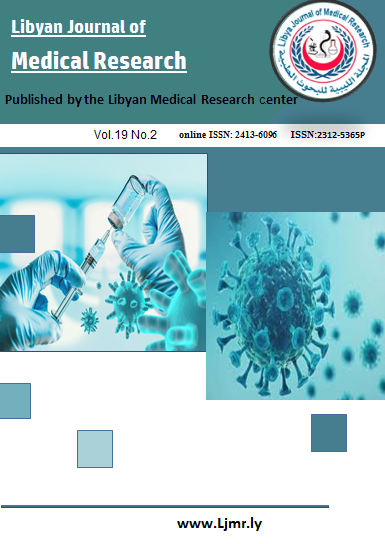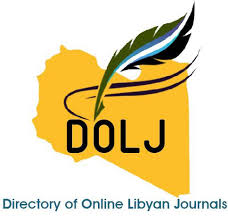Infantile urinary tract infection, presentations and outcomes in General Hospital, Tripoli, Libya: A Single-Center retrospective analytical cross-sectional study
DOI:
https://doi.org/10.54361/LJMR.19.2.42Keywords:
Urinary tract infection, presentations, outcomes, hospitalization, Tripoli, LibyaAbstract
Background: Urinary tract infection (UTI) is a common cause of fever and hospitalization in infants. Early diagnosis and management are vital to prevent short and long-term complications. We aimed to describe clinical features, laboratory and imaging findings, risk factors, and short-term outcomes among infants <1 year hospitalized with UTI. Materials and Methods: A Single-Center retrospective analytical cross-sectional study was conducted at the Pediatric Department of Al-Hadaba Al-Khadra General Hospital, Tripoli, Libya. Data including fifty (50) infants hospitalized with a confirmed diagnosis of UTI between January and October 2024. Data were extracted from medical records, including demographics, presentation, laboratory results, imaging, risk factors, and outcomes. All infants received broad-spectrum intravenous antibiotics adjusted according to culture sensitivity. Statistical analysis was performed using SPSS version 25. Descriptive statistics are used to summarize infants' characteristics. Associations were tested using Fisher’s exact/Chi-square, and logistic regression was planned for independent predictors. P < 0.05 was significant. Results: Fifty infants were included. Fever (96%) and vomiting (68%), were the most frequent symptoms. Abnormal renal ultrasound was detected in (44%), and positive urine culture in (14%). Eight infants (16%) had identifiable risk factors: Spina bifida (2), antenatal hydronephrosis (1), renal hypoplasia (1), maternal antenatal UTI (2), prolonged rupture of membranes (2), and uncircumcised males (4). Prolonged stay occurred in (22%), recurrence in (24%), and sepsis in (8%). Abnormal ultrasound and positive culture were independent predictors of prolonged stay, while risk factors and abnormal imaging predicted recurrence. Conclusion: UTI in infants commonly presents with systemic symptoms and significant imaging abnormalities. Abnormal renal ultrasound is a key predictor of prolonged stay, recurrence, and complications, highlighting the need for early imaging and structured follow-up of high-risk infants to prevent renal damage.
Downloads
References
1. Practice parameter: Diagnosis, treatment, and evaluation of initial urinary tract infections in febrile infants and young children. American Academy of Pediatrics. Committee on Quality Improvement. Subcommittee on Urinary Tract Infection. Pediatrics. 1999 Apr;103(4 Pt 1):843-52. doi: 10.1542/peds.. 103.4.843. Erratum in: 2000 Jan;105(1 Pt 1):141. Erratum in: Pediatrics 1999 May;103(5 Pt 1):1052, 1999 Jul;104(1 Pt 1):118. PMID: 10103321.
2. National Institute for Health and Care Excellence (NICE). Urinary tract infection in under 16s: diagnosis and management. London (UK): NICE; 2018 Oct.
3. Shaikh N, Morone NE, Bost JE, Farrell MH. Prevalence of urinary tract infection in childhood: a meta-analysis. Pediatr Infect Dis J. 2008; 27 (4):302-308.
4. Singh-Grewal D, Macdessi J, Craig J. Circumcision for the prevention of urinary tract infection in boys: a systematic review of randomised trials and observational studies. Arch Dis Child. 2005; 90 (8):853-858. doi:10.1136/adc.2004.049353.
5. Roberts KB; Subcommittee on Urinary Tract Infection, Steering Committee on Quality Improvement and Management. Urinary tract infection: clinical practice guideline for the diagnosis and management of the initial UTI in febrile infants and children 2 to 24 months. Pediatrics. 2011; 128 (3):595-610. doi:10.1542/peds.2011-1330.
6. Salo J, Ikäheimo R, Tapiainen T, Uhari M. Childhood urinary tract infections as a cause of chronic kidney disease. Pediatrics. 2011; 128 (5):840-847. doi:10.1542/peds.2010-3520.
7. Shaikh N, Ewing AL, Bhatnagar S, Hoberman A. Risk of renal scarring in children with a first urinary tract infection: a systematic review. Pediatrics. 2010; 126 (6):1084-1091.
8. Greenhow TL, Hung YY, Herz AM. Bacteremia in previously healthy febrile infants aged 1 to 90 days. Pediatrics. 2017;139 (3):e20162016.
9. Mattoo TK. Vesicoureteral reflux and reflux nephropathy. Adv Chronic Kidney Dis. 2011; 18(5):348-354.
10. Montini G, Zucchetta P, Tomasi L, et al. Value of imaging studies after a first febrile urinary tract infection in young children: data from the Italian renal infection study. Pediatrics. 2009; 123 (2):e239-e246. doi:10.1542/peds.2008-1003.
11. Biggi A, Dardanelli L, Pomero G, Cussino P, Noello C, Sernia O, et al. Acute renal cortical scintigraphy in children with a first urinary tract infection. Pediatr Nephrol. 2001; 16(9):733-738.
12. Abdelrahman SM, et al. Urinary tract infection in infants and young children in Sudan: a clinical and bacteriological study. J Trop Pediatr. 2019;65 (3):243-251.
13. Craig JC, Simpson JM, Williams GJ, et al. Antibiotic prophylaxis and recurrent urinary tract infection in children. N Engl J Med. 2009; 361 (18):1748-1759.
14. Keren R, Shaikh N, Pohl H, Gravens-Mueller L, Ivanova A, Zaoutis L, et al. Risk factors for recurrent urinary tract infection and renal scarring. Pediatrics. 2015; 136 (1):e13-e21.
15. Park S, Han JY, Kim KS. Risk factors for recurrent urinary tract infection in infants with vesicoureteral reflux during prophylactic treatment: effect of delayed contrast passage on voiding cystourethrogram. Urology. 2011; 78 (1):170-173.
16. Herz AM, Greenhow TL, Alcantara J, et al. Bacteremia in children with urinary tract infection. Pediatr Infect Dis J. 2016; 35 (8):857-861.
17. Montini G, Tullus K, Hewitt I. Febrile urinary tract infections in children. N Engl J Med. 2011; 365 (3):239-250. doi: 10.1056/NEJMra1007755.
18. Fan NC, Chen HH, Chen CL, Ou LS, Lin TY, Tsai MH, et al. Rise of community-onset urinary tract infection caused by extended-spectrum β-lactamase-producing Escherichia coli in children. J Microbiol Immunol Infect. 2014; 47 (5):399-405.
Downloads
Published
Issue
Section
License
Copyright (c) 2025 Fathia Hameda Ben Saleh, Zinab Ashour Saad, Aisha A. Sehari Gammodi (Author)

This work is licensed under a Creative Commons Attribution-NonCommercial-NoDerivatives 4.0 International License.
Open Access Policy
Libyan journal of medical Research (LJMR).is an open journal, therefore there are no fees required for downloading any publication from the journal website by authors, readers, and institution.
The journal applies the license of CC BY (a Creative Commons Attribution 4.0 International license). This license allows authors to keep ownership f the copyright of their papers. But this license permits any user to download , print out, extract, reuse, archive, and distribute the article, so long as appropriate credit is given to the authors and the source of the work.
The license ensures that the article will be available as widely as possible and that the article can be included in any scientific archive.
Editorial Policy
The publication of an article in a peer reviewed journal is an essential model for Libyan journal of medical Research (LJMR). It is necessary to agree upon standards of expected ethical behavior for all parties involved in the act of publishing: the author, the journal editorial, the peer reviewer and the publisher.
Any manuscript or substantial parts of it, submitted to the journal must not be under consideration by any other journal. In general, the manuscript should not have already been published in any journal or other citable form, although it may have been deposited on a preprint server. Authors are required to ensure that no material submitted as part of a manuscript infringes existing copyrights, or the rights of a third party.
Authorship Policy
The manuscript authorship should be limited to those who have made a significant contribution and intellectual input to the research submitted to the journal, including design, performance, interpretation of the reported study, and writing the manuscript. All those who have made significant contributions should be listed as co-authors.
Others who have participated in certain substantive aspects of the manuscript but without intellectual input should only be recognized in the acknowledgements section of the manuscript. Also, one of the authors should be selected as the corresponding author to communicate with the journal and approve the final version of the manuscript for publication in the LJMR.
Peer-review Policy
- All the manuscripts submitted to LJMR will be subjected to the double-blinded peer-review process;
- The manuscript will be reviewed by two suitable experts in the respective subject area.
- Reports of all the reviewers will be considered while deciding on acceptance/revision or rejection of a manuscript.
- Editor-In-Chief will make the final decision, based on the reviewer’s comments.
- Editor-In-Chief can ask one or more advisory board members for their suggestions upon a manuscript, before making the final decision.
- Associate editor and review editors provide administrative support to maintain the integrity of the peer-review process.
- In case, authors challenge the editor’s negative decision with suitable arguments, the manuscript can be sent to one more reviewer and the final decision will be made based upon his recommendations.













